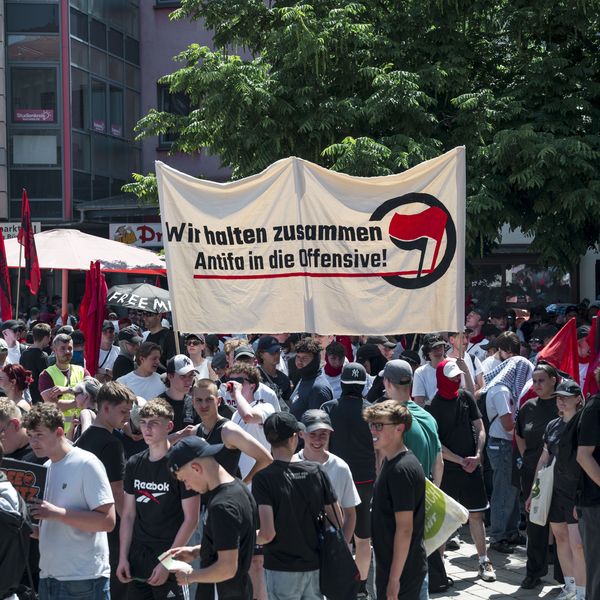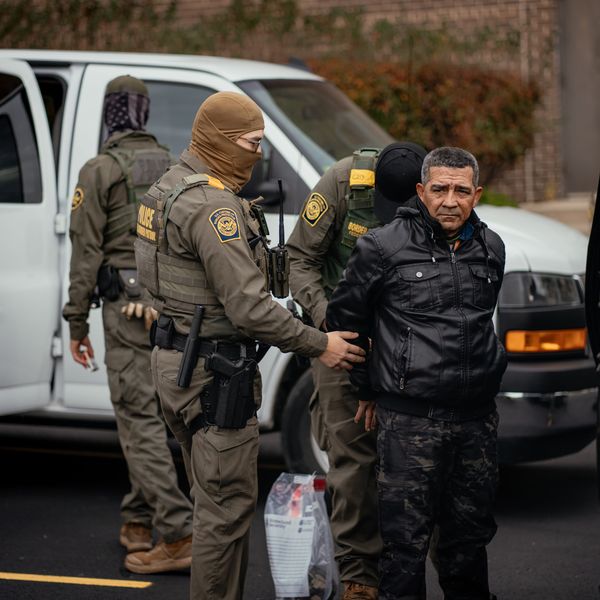Why Are Persons Unknown More Likely to Be Called 'Terrorist' Than a Known White Supremacist?
In the wake of mass violence, a nation struggling to understand turns to its news outlets to see how they frame events. The language journalists use in the immediate aftermath of a bloodbath helps form public attitudes and has a major impact on official reactions.
When two bombs went off at the Boston Marathon on April 15, 2013, killing three and injuring hundreds, it was inevitably a huge story: A search of the Nexis news database for US newspapers on the next day turns up 2,593 stories mentioning the marathon, virtually all of them about the bombing. Of these, 887, or 34 percent, used the word "terrorism" or a variant ("terrorist," "terroristic" etc.)-even though the bombers, let alone the bombers' motivations, would not be known until days later.
When nine people were killed at Emanuel African Methodist Episcopal Church on April 17, 2015, there were 367 stories in the next day's papers that mentioned "Charleston" and "church," according to Nexis-a big story, though not given the blockbuster treatment of the Boston Marathon bombing. Of these 367 stories, 24 mentioned "terrorism" or "terrorist"-just 7 percent, even though a suspect, Dylann Roof, was named on the first day, with evidence presented that he was motivated by a white supremacist ideology and a desire "to start a civil war" (Columbia, S.C. State, 6/18/15).
Some suggest that the word "terrorism" has been so politically manipulated and selectively applied that we would do well to drop the whole concept. But politically motivated violence that targets civilians-which is the core of the various definitions of "terrorism"-is an actual phenomenon that is hard to talk about without a label.
If media are going to use the word, though, they need to have a single standard for its application. By applying the word to a bombing with initially unknown perpetrators, and largely declining to use it in connection with a massacre allegedly perpetrated by a white supremacist hoping to spark a race war, media failed that test.
An Urgent Message From Our Co-Founder
Dear Common Dreams reader, The U.S. is on a fast track to authoritarianism like nothing I've ever seen. Meanwhile, corporate news outlets are utterly capitulating to Trump, twisting their coverage to avoid drawing his ire while lining up to stuff cash in his pockets. That's why I believe that Common Dreams is doing the best and most consequential reporting that we've ever done. Our small but mighty team is a progressive reporting powerhouse, covering the news every day that the corporate media never will. Our mission has always been simple: To inform. To inspire. And to ignite change for the common good. Now here's the key piece that I want all our readers to understand: None of this would be possible without your financial support. That's not just some fundraising cliche. It's the absolute and literal truth. We don't accept corporate advertising and never will. We don't have a paywall because we don't think people should be blocked from critical news based on their ability to pay. Everything we do is funded by the donations of readers like you. Will you donate now to help power the nonprofit, independent reporting of Common Dreams? Thank you for being a vital member of our community. Together, we can keep independent journalism alive when it’s needed most. - Craig Brown, Co-founder |
In the wake of mass violence, a nation struggling to understand turns to its news outlets to see how they frame events. The language journalists use in the immediate aftermath of a bloodbath helps form public attitudes and has a major impact on official reactions.
When two bombs went off at the Boston Marathon on April 15, 2013, killing three and injuring hundreds, it was inevitably a huge story: A search of the Nexis news database for US newspapers on the next day turns up 2,593 stories mentioning the marathon, virtually all of them about the bombing. Of these, 887, or 34 percent, used the word "terrorism" or a variant ("terrorist," "terroristic" etc.)-even though the bombers, let alone the bombers' motivations, would not be known until days later.
When nine people were killed at Emanuel African Methodist Episcopal Church on April 17, 2015, there were 367 stories in the next day's papers that mentioned "Charleston" and "church," according to Nexis-a big story, though not given the blockbuster treatment of the Boston Marathon bombing. Of these 367 stories, 24 mentioned "terrorism" or "terrorist"-just 7 percent, even though a suspect, Dylann Roof, was named on the first day, with evidence presented that he was motivated by a white supremacist ideology and a desire "to start a civil war" (Columbia, S.C. State, 6/18/15).
Some suggest that the word "terrorism" has been so politically manipulated and selectively applied that we would do well to drop the whole concept. But politically motivated violence that targets civilians-which is the core of the various definitions of "terrorism"-is an actual phenomenon that is hard to talk about without a label.
If media are going to use the word, though, they need to have a single standard for its application. By applying the word to a bombing with initially unknown perpetrators, and largely declining to use it in connection with a massacre allegedly perpetrated by a white supremacist hoping to spark a race war, media failed that test.
In the wake of mass violence, a nation struggling to understand turns to its news outlets to see how they frame events. The language journalists use in the immediate aftermath of a bloodbath helps form public attitudes and has a major impact on official reactions.
When two bombs went off at the Boston Marathon on April 15, 2013, killing three and injuring hundreds, it was inevitably a huge story: A search of the Nexis news database for US newspapers on the next day turns up 2,593 stories mentioning the marathon, virtually all of them about the bombing. Of these, 887, or 34 percent, used the word "terrorism" or a variant ("terrorist," "terroristic" etc.)-even though the bombers, let alone the bombers' motivations, would not be known until days later.
When nine people were killed at Emanuel African Methodist Episcopal Church on April 17, 2015, there were 367 stories in the next day's papers that mentioned "Charleston" and "church," according to Nexis-a big story, though not given the blockbuster treatment of the Boston Marathon bombing. Of these 367 stories, 24 mentioned "terrorism" or "terrorist"-just 7 percent, even though a suspect, Dylann Roof, was named on the first day, with evidence presented that he was motivated by a white supremacist ideology and a desire "to start a civil war" (Columbia, S.C. State, 6/18/15).
Some suggest that the word "terrorism" has been so politically manipulated and selectively applied that we would do well to drop the whole concept. But politically motivated violence that targets civilians-which is the core of the various definitions of "terrorism"-is an actual phenomenon that is hard to talk about without a label.
If media are going to use the word, though, they need to have a single standard for its application. By applying the word to a bombing with initially unknown perpetrators, and largely declining to use it in connection with a massacre allegedly perpetrated by a white supremacist hoping to spark a race war, media failed that test.

